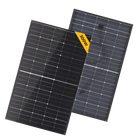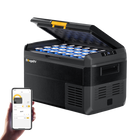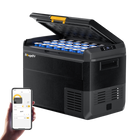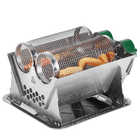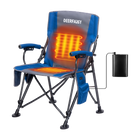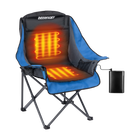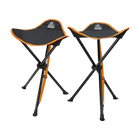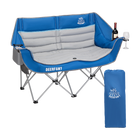How to Reduce the Power Consumption of Your Portable Refrigerator

In the hot summer, portable refrigerators have become an essential companion for outdoor enthusiasts. Whether you're camping in the wilderness, embarking on a cross-country road trip, or enjoying a weekend getaway, a portable refrigerator ensures your food stays fresh and your drinks remain chilled. While portable refrigerators are undeniably convenient, they can consume a significant amount of power, which may pose challenges for those relying on limited energy sources such as car batteries, solar panels, or portable power stations.
In this blog post, we’ll explore the power consumption of portable refrigerators, the factors that influence their energy usage, and—most importantly—how you can reduce their power consumption. By optimizing your refrigerator's efficiency, you can not only extend your adventures but also contribute to a greener planet. Let’s dive in!
How Much Electricity Does a Portable Refrigerator Use
Portable refrigerators typically operate on 12V DC power (from a car battery) or 110V/220V AC power (from a wall outlet or inverter). Their power consumption is measured in watts or amp-hours, and it varies depending on the model, size, and temperature settings.
On average, a mini fridge consumes between 50 and 100 watts of power during operation and requires 200 to 400 watts to start up. However, actual energy usage can vary depending on factors such as the model, size, and overall efficiency of the appliance. For instance, Energy Star-certified mini fridges and those equipped with energy-saving modes are designed to use significantly less power, making them more energy-efficient options.
Factors That Influence the Power Consumption of Portable Refrigerators
1. Ambient Temperature
The temperature of your surroundings plays a significant role. The hotter the environment, the harder your refrigerator has to work to maintain its internal temperature. For example, if you're camping in the summer heat or parking your car in direct sunlight, the compressor will run more frequently, using more power.
2. Size and Capacity
Larger refrigerators typically consume more power than smaller ones. However, an overfilled refrigerator can also strain the compressor, while an underfilled one wastes cooling capacity. Striking the right balance is key.
3. Insulation Quality
The quality of your refrigerator’s insulation determines how well it retains cool temperatures. Poor insulation allows cold air to escape, forcing the compressor to work harder.
4. Frequency of Door Openings
Every time you open the refrigerator door, warm air enters, and the compressor has to work harder to restore the desired temperature. Frequent door openings can significantly increase power consumption.
5. Temperature Settings
Setting your refrigerator to extremely low temperatures (e.g., below freezing) can increase energy usage. Keeping the temperature just cool enough for your needs is more efficient.
6. Power Source Efficiency

Not all power sources are created equal. For instance, running your refrigerator on a car battery may be less efficient than using a dedicated power station or solar panel, depending on their respective capacities and outputs.
How to Reduce the Power Consumption of Your Portable Refrigerator
Now that you understand the factors influencing power consumption, let’s look at actionable steps to reduce it. These tips will help you save energy, extend your battery life, and minimize your environmental impact—all while keeping your food and drinks perfectly chilled.
1. Pre-Cool Your Portable Refrigerator
Before heading out on your trip, plug your portable refrigerator into a wall outlet at home and let it cool down to the desired temperature. This way, it doesn’t need to work as hard to reach the target temperature once you’re on the go.
2. Optimize Placement
Avoid direct sunlight: Place your refrigerator in a shaded or well-ventilated area to reduce the impact of external heat.
Elevate it: Place the portable refrigerator on a raised surface to allow better air circulation for the compressor.
3. Use a Quality Insulation Cover
Investing in a high-quality, portable refrigerator with excellent insulation is one of the most effective ways to conserve energy. A well-insulated refrigerator minimizes temperature loss, reducing the workload on the compressor.
4. Set an Efficient Temperature
Having a portable refrigerator with precise temperature control can make a big difference in power consumption. For instance, a portable refrigerator with adjustable temperature settings allows you to customize it to your needs, keeping your food fresh while minimizing energy waste.
5. Minimize Door Openings
For example, group the items you’ll need together so you can retrieve them all at once. Each moment the door is open lets warm air in, making the compressor work harder to maintain the desired temperature.
6. Don’t Overfill or Underfill
Overfilling: Blocks airflow inside the refrigerator, making it harder to cool evenly.
Underfilling: Creates empty spaces that warm up quickly. Use ice packs or frozen water bottles to fill unused space and help maintain a stable temperature.
7. Leverage Solar Power
If you're looking for a refrigerator that pairs perfectly with solar panels for a truly off-grid experience, the BougeRV 12V portable refrigerator is a fantastic option. Designed for energy efficiency, these refrigerators work seamlessly with solar power systems, making them ideal for reducing your carbon footprint while keeping your food and drinks cool.
8. Turn It Off When Not in Use
If you’re not using the refrigerator for an extended period (e.g., overnight), consider turning it off to conserve power. Just make sure the contents won’t spoil during this time.
Clean the condenser coils: Dust and dirt can reduce the efficiency of your portable refrigerator.
Check the seals: Ensure the door seals are airtight to prevent cold air from escaping.
Inspect the compressor: A well-maintained compressor operates more efficiently.
The Environmental Impact of Energy-Efficient Practices

Reducing the power consumption of your portable refrigerator isn’t just about saving battery life—it’s also about protecting the environment. By using less energy, you’re reducing greenhouse gas emissions associated with power generation. This is especially important if you’re relying on fossil fuel-based energy sources.
Additionally, adopting energy-efficient practices aligns with the growing global movement toward sustainability. Small changes, such as optimizing your refrigerator’s performance, contribute to a larger collective effort to reduce waste and preserve natural resources.
Final Thoughts
Portable refrigerators are a game-changer for outdoor adventures, but managing their power consumption is crucial for maximizing their benefits. By following the tips outlined in this guide, you can reduce energy usage, save money on power sources, and minimize your environmental impact—all while enjoying fresh food and cold drinks wherever your journey takes you. Ready to upgrade your camping or road trip experience with a reliable portable refrigerator?
FAQs
1. How long can I run a portable refrigerator on a car battery?
The runtime of a portable refrigerator on a car battery depends on the refrigerator’s power consumption and the battery’s capacity. For example, if your refrigerator consumes 50 watts per hour and your car battery has a capacity of 60Ah, you can expect it to run for about 10-12 hours before the battery is drained. To avoid draining your car battery completely, consider using a dual battery system or a portable power station.
2. Can I use solar panels to power my portable refrigerator?
Yes, you can! Many portable refrigerators are compatible with solar panels. Using solar panels is a great way to reduce your environmental impact. It's important to ensure compatibility between the portable refrigerator and the solar panel, power station, or solar generator. Make sure the power source matches the refrigerator's power requirements to ensure optimal performance and efficiency.
3. What’s the ideal temperature setting for a portable refrigerator?
The ideal temperature setting depends on what you’re storing. For most food and beverages, a temperature of 37-40°F (3-4°C) is sufficient. If you’re storing frozen goods, you can set the temperature lower, but keep in mind that this may increase power consumption.


